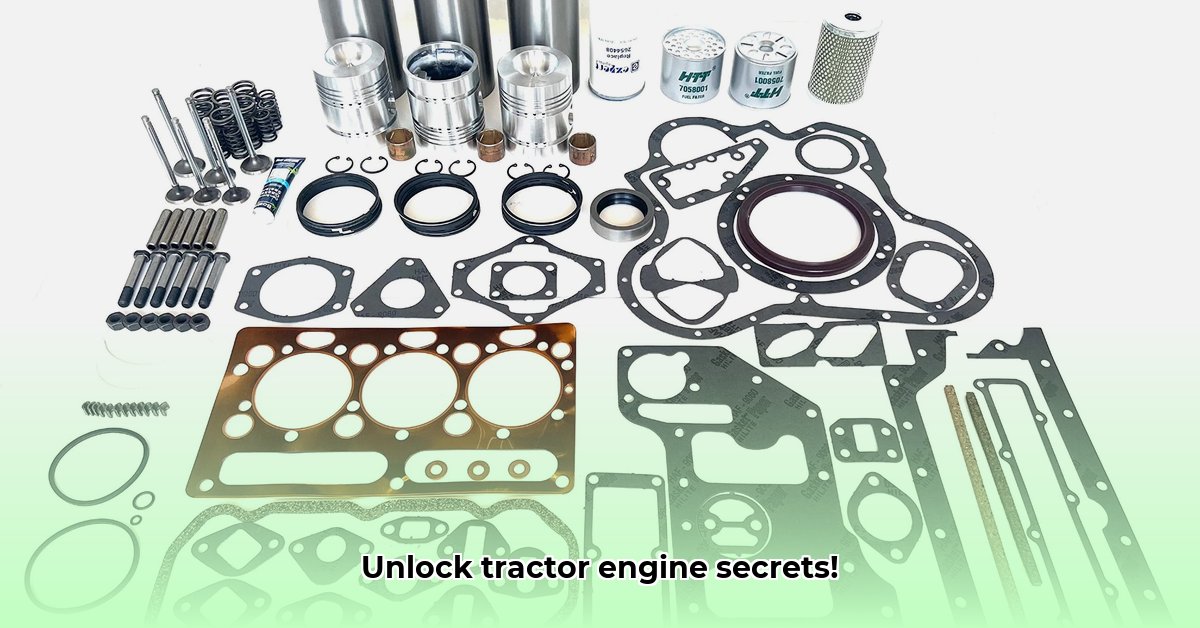
Tractor Engine Parts: Your Key to Sustainable Farming
Your tractor's engine is the heart of your operation. Keeping it healthy is vital for both efficient farming and environmental sustainability. This guide explores essential tractor engine parts, their functions, maintenance, and how they impact fuel economy and environmental responsibility. Whether you're a seasoned farmer or just starting, understanding these components will improve your farm's efficiency and reduce its footprint. For detailed diagrams, check out this helpful resource on Ford 3600 tractor parts.
Getting to Know the Engine's Inner Workings
Let's examine the major components that drive your tractor. They work in concert, converting fuel into the power that keeps your farm running.
Engine Block (The Foundation): This sturdy base supports all the moving parts. Think of it as the engine's skeleton, crucial for durability and longevity. A well-maintained block is essential for long-term performance.
Cylinder Head (The Combustion Chamber): Located atop the engine block, it houses the combustion chambers where fuel and air mix and ignite, generating power. Regular inspections here are critical.
Pistons and Connecting Rods (The Power Transfer Team): Pistons move within the cylinders, and connecting rods convert their linear motion into rotational power. These are the engine's workhorses, and wear and tear can lead to power loss.
Crankshaft (The Rotating Powerhouse): This component converts the pistons' linear motion into the steady rotary motion that drives the tractor. Maintaining its balance is crucial to prevent vibrations and damage.
Valves and Camshaft (Precise Timing is Key): The camshaft controls valve timing, regulating air and fuel intake and exhaust output. Precise timing is essential for fuel efficiency. Improper timing reduces power and increases fuel consumption.
Fuel Efficiency: Saving Money and the Planet
Sustainable farming demands fuel efficiency. Several engine components directly influence this.
Fuel Injectors (Precise Fuel Delivery): These precisely meter fuel into the combustion chamber. Faulty injectors waste fuel, impacting both your budget and the environment. Regular cleaning or replacement is often a cost-effective solution. Did you know that poorly maintained fuel injectors can decrease fuel efficiency by up to 15%?
Air Filter (Breathing Easy): A clean air filter ensures proper air/fuel mixture for efficient combustion. A clogged filter restricts airflow, reducing power and increasing fuel consumption. Regular replacement is critical for optimal performance. Replacing a clogged air filter can improve fuel economy by up to 10%.
Turbocharger (If Equipped) (A Power Boost): Turbochargers increase air intake, boosting power and potentially improving fuel efficiency. However, they require careful maintenance; damage can lead to costly repairs.
Regular maintenance of these parts is key to maximizing fuel efficiency, saving you money and minimizing your environmental impact.
Maintaining Your Tractor Engine: A Simple Guide
Preventative maintenance is crucial. It's far less expensive than repairs!
Oil Changes (The Life Blood): Follow your tractor's manual for oil type and change intervals. Clean oil lubricates moving parts, preventing wear and tear. Regular oil changes can extend engine life by up to 25%.
Air Filter Inspection (A Breath of Fresh Air): Regularly check and replace the air filter. A clogged filter impacts engine performance and fuel economy.
Fuel Filter Maintenance (Clean Fuel is Key): A clean fuel filter ensures clean fuel reaches the injectors. Dirty fuel can clog injectors and cause significant problems.
Coolant System Check (Keep Your Cool): Check coolant levels and look for leaks. Overheating can cause severe engine damage.
Visual Inspections (Catching Problems Early): Regularly inspect belts, hoses, and components for cracks or wear. Early detection can prevent major issues.
Choosing Sustainable Tractor Engine Parts
When replacing parts, consider sustainable options:
Remanufactured Parts (A Second Life): These are often cost-effective and environmentally friendly, reducing waste and lowering your overall impact.
Eco-Friendly Materials (Going Green): Some manufacturers use bio-based materials or recycled components, offering environmental benefits.
Maintaining your tractor engine is an investment in both your farm's health and the planet's. Regular maintenance and wise parts choices contribute greatly to sustainable farming.